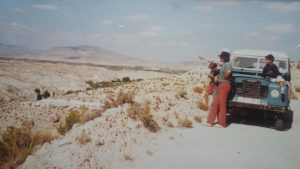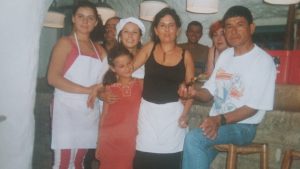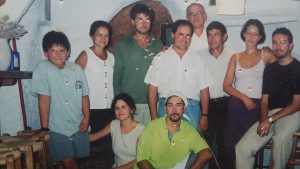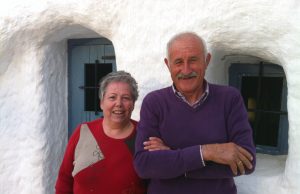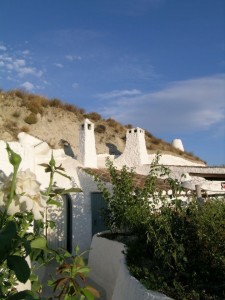The story begins in the nineties… Isabel is Spanish and her husband Luc is from Paris. They are young and full of dreams and destiny takes them to Baza: a big town, or a small city as the locals say, it’s all a question of perspective.
Isa is a teacher working for the Junta de Andalusia (the government of the Autonomous Community). They had sent her to this place in the foothills of the Sierra de Baza to teach in a secondary school. For the young couple it’s an adventure. They don’t know anybody, they don’t know where to stay and their first child Mateo is only 1 year old.
They don’t really feel like living in the town centre. For the cosmopolitan Luc it is the opportunity for a change. They agree that they would like to live closer to nature, maybe in the countryside or with a garden to grow vegetables. The estate agent that takes care of them does not really find anything that matches with their expectations. He suggests: “go to the upper town and ask for a man called Tote, I believe he has a cave to sell.” Both Luc and Isabel looked at him wide-eyed and asked at the same time: “What is that?”
Isabel’s colleagues at the school throw pitiful looks at her, making comments such as “oh dear”, “are you crazy”, “there are so many beautiful and luxurious new residential areas in Baza and you want to buy a cave!!!???”
In those days people would change a cave for a washing machine… those who lived in cave houses often did not belong to the well-respected population of the locality. The bourgeoisie considered caves as poor-housing and accommodation for marginal groups of the society. In official documents they were described as precarious lodgings.
When Luc and Isa met Enrique y Marisa who lived in a beautiful cave, they found moral support and no longer felt to be the only ‘weirdos’ in the area. They were discovering this new World of troglodyte dwellings and they were simply enchanted. They bought and endeavoured to refurbish the cave-house of “Tote” situated in the upper part of Baza on a hillside and presiding over the vast horizon, over their new vast horizon. Barbara, their second child, was born. Unknowingly they had given their daughter the name of the patron saint of Baza and this way gave credit to their process of integration.
With the help of Adrian, a retired handicraft cave builder, Luc learned how to use the pickaxe for carving his new home. He lost many kilos and got many blisters and calluses during the process of picking ventilation tunnels, skylights, bedroom alcoves… quite an experience for someone who had spent his childhood with all comforts in the City of Lights. During the refurbishment Adrian introduced Luc into the secrets of a cave builder. You have to observe the veins, spot the structurally weak points, the compensation crack (“grieta madre”), to calibrate the impermeability of the hill etc. Adrian taught Luc the very specific traditional know-how to build this popular dwelling, a technique passed down from generation to generation until the mid-20th century. Somehow it represented architecture without an architect.
While Luc sculptured earth and rock he had a lot of time to reflect. The history of the troglodyte was very important in Baza but wasn’t appreciated by anybody in the area. Nonetheless the cave house areas were very picturesque and held so much creative potential. He thought that it would fascinate foreigners and people from other parts of Spain in the same way as it did to him. The question was how to show its value properly? His fellow countryman and friend Pascal, who had been living in the Altiplano of Granada for many years and was a fine connoisseur of the local wonders, motivated him.
And so bubbling over with ideas Luc started what he called the “espejuelo” project. Espejuelos are laminated gypsum crystals and the name means “little mirrors”. You can find a lot of them in the desert-like countryside and in the walls of the local caves. Luc wanted to show the caves to the world and it took him 2 years to prepare the project of his dreams. He needed funding for what he had in mind. At the same time he continued picking and started refurbishing caves for his friends and family as his enthusiasm for cave modeling and life was quite contagious.
Luc had discovered that there were many abandoned cave hamlets in the area. The inhabitants left their cave-houses in the 1960’s as they were considered to be for poor people. Furthermore many locals emigrated to Barcelona, Madrid or to other more prosperous cities and countries to find better jobs and new opportunities. Luc’s plan was to show the value of the cave-housing through the creation of a small and cozy tourist complex where people could find a place to stay, enjoy nature and traditions, such as culinary ones and the bath tradition. He respected the natural physiognomy and the bioclimatic properties of the troglodyte habitat and searched for a combination of ecological solutions and maximum comfort in a high standard accommodation.
Aboard a ramshackle Landrover, he travelled through the region in search for the ideal hamlet for his project. Sometimes his son Mateo came with him because he very much enjoyed entering into the “holes”. The next step was the evaluation of the visited sites. Luc followed a strict map of criteria in order to find the right place. After a dozen tyre punctures and more than a couple of frights, he was close to a decision.
During Christmas ’95 he took a short holiday in France with his family. When he explained his project his younger brother Eloi and his cousin Christophe laughed at him saying his idea was totally unrealistic… but only a few days later, Eloi said that he wanted to participate in the adventure.
The upcoming spring Luc took Eloi around all the beautiful spots in the Altiplano he had discovered and the different areas he had identified as suitable for a troglodyte holiday resort. Together they made the final choice: the area of the Arroyo Cúrcal.
During the following months they suffered from uncertainty, but one sunny day in July 1995 Luc called his brother in France to announce that he had bought the first cave in the hamlet.
A year later, the exhausting and delicate cave and land acquisition process was brought successfully to an end. Isabel had become an expert in diplomatic negotiations and deals, and José María, the shepherd of the territory around the rivulet had provided them priceless support. He was the last person in the neighborhood to work the land and look after the sheep from morning to night and, most important, he had an elephant’s memory, he remembered all the people who had lived and worked on this land during his childhood and he helped to find the original owners of the abandoned caves.
The remaining obstacle was the financing of the project and its development. The two brothers and Isabel managed to convince their grandparents, parents, brothers and sisters to contribute money and create a Franco-Spanish co-operative to ensure the project’s viability. It also attracted the interest of some public administrators due to its uniqueness. In 1998 the private Limited Society Hijos de Gaya S.L. is brought into being. “Gaia” was an ancient goddess of the Earth and the new company is called “children of the earth”.
They felt like real pioneers. There was another eccentric forerunner in Galera who had the idea to show the world the wonderful World of cave-housing in the Altiplano area but there was nobody yet who had built a Hammam into a cave… They were the first.
Public baths were popular during the Islamic Caliphate. Luc wanted to resume the tradition and offer the future guests relaxation and wellness in a place where they would come to encounter the womb of Mother Earth. He imagined the sinuous shapes that surround you during silent nights that guarantee a deep and therapeutic sleep.
In 1998 the Andalusian authorities started to promote a new cultural route in the south of Spain. It was named after the emissary Ibn Al Jatib. The route starts in Granada capital, passes the Arroyo Cúrcal close to the hamlet that Luc had acquired and ends in Murcia. In the area there were troglodyte fortified shelters called Hafas used by Almohad tribes in the 12th century. During the time of the Moriscos (Muslim converts) the cave dwellings became very popular. All these discoveries were taken into account in the moment of choosing a name for the project. Long lists were faxed between Spain and France with suggestions… At the end, the cave complex was baptized “Cuevas Al Jatib”.
Before the hamlet could shine in a new light, restored and with a fresh coat of lime, there was a lot of hard work to do!! There was no public water supply in the area yet and the water from the nearby rivulet was too brine and of no use for the cement production. Every day Luc and Eloi had to bring 1000 litres of water to the building site using their old grandfathers van. One day on a road with a slope with Luc driving and the children standing on the open platform of the trailer, the water tank got loose, fortunately José Carlos was there to pull them out of the way just in time before the tank toppled over.
There was no electricity either and the portable generator would stop every now and then… Luc and Eloi are artists; they wanted to restore the caves themselves, as they were in a quite ruinous state, the building project was huge and they are very meticulous people. Some of the builders, electricians, plumbers and other workers that came to offer their services believed that they were totally crazy and they also tried to cheat a little, thinking that they could do it with foreigners that had no idea of the circumstances and prices in the area. Others don’t have enough knowledge and experience to be able to resolve the technical challenge of a Hamman inside the rock for example. They lost a lot of time searching for solutions; the tension was palpable on the building site, between the workers as well as amongst the family members. But they did not give up.
In April 2001 Luc and Isabel could finally open their holiday Cave resort Cuevas Al Jatib. Almost 7 years had gone past since the idea was born in Luc’s creative mind. The result was worth the effort and just amazing. Soon their troglodyte hamlet became a reference for the tourism sector of the region and was shown in international magazines for rural living and interior design.
The access to the caves was still quite challenging as there was only a track road that transformed into a slippery mud rink every time it rained. Our guests would try to get to Al Jatib but some got off the road or their car got stuck into the gypseous mud… or they got lost trying to find an alternative road. Luc or Antonio had to go and rescue someone during the night a couple of times.
When our adventurers were about to lose their spirits, Matt, Claudia and other friends encouraged them and supported them to keep going.
Isabel, despite her full-time job as a secondary school teacher, decided to take the management of the restaurant. She found some traditional arabo-andalusian and local recipes such as “Gachas tortas” for example. She grew her own fresh vegetables on a patch of land next to the caves and the kitchen.
Mateo, Barbara and Inés (the most recent new member of the family) played all over the place, discovered the surroundings, ran along the many rural paths and over the fields, climbed the trees or played in the mole’s cave. Quite often they fell asleep listening to the sound panorama of the restaurant, of the clinking glasses and pots and conversations of the guests in the tearoom or bar or noises of the children in the children’s cave.
Despite the difficulties Luc and Isabel managed to address all issues with humor, they built a team for the different areas such as maintenance, gardening, restaurant, reception and room service counting on Antonio, Santiago, Mónica, Pablo, Javier, Jeanneth, Galo, Mercedes, Montse, Lucía, Encarni, Adriana, Chencho, Carlos, M.Dolores, F. Javier, Zacharías, Claudia, Belen, Manuela, A. Belén, Kate, Juani… during the years many people helped and collaborated to make Cuevas Al Jatib a special place.
In 2006 Eloi and Julio take over the responsibility for the exploitation and development of the complex. They built the beautiful outdoor pool with its changing room and shower facilities which were inaugurated in 2009.
In November 2012 Mateo, Luc and Isa’s son who is now already 22 years old, decides to steer the family business. First Maribel, one of Al Jatib’s oldest and most loyal guests and later David assist him with their expertise and experience.
In November 2013 when Mateo wishes to work in his father’s homeland, Luc comes back to manage the cave resort to make sure that the small hamlet remains one of the most beautiful amongst the many cave that have been reformed since he had an idea, a dream… and transformed it into Cuevas Al Jatib together with his wife and his brother.
